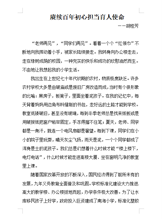doubt的用法全解析
今天给大家带来了毫无疑问:doubt的用法全解析,我们一起来学习吧,下面小编就和大家分享,来欣赏一下吧。
毫无疑问:doubt的用法全解析
When in doubt, go to the library.
——J.K. Rowling《Harry Potter and the Chamber of Secrets》
有疑问的时候,去图书馆。
——J·K·罗琳《哈利波特与密室》
一、下面我们来看看doubt有几种含义
n.
疑惑,疑问,不确定,不相信 [U,C]
There is no doubt but that he will win the election.
毫无疑问,他将在竞选中获胜。
v.
1.对…无把握,不能肯定,认为…未必可能 [I]
They have never doubted of success.
他们对成功从未怀疑过。
2.怀疑,不相信,不信任 [T]
I doubt whether Tom has taken my watch.
我怀疑汤姆是否拿了我的手表。
3.【古】恐怕 [I,T]
二、词义辨析:doubt(名词词义 “怀疑” )还有哪些近义词呢?
doubt, supicion, distrust, uncertainty
这些名词均有“怀疑”之意。
doubt指对事物的真、假有怀疑。
supicion语气较强,指对某人做某事的目的、意图有怀疑,或认为某人做错事,但无确凿证据而产生怀疑。
distrust一般用词,泛指对某人某事不信任而感到怀疑。
uncertainty侧重指对某事或选择等需作决定时的迟疑不决。
三、词义辨析:doubt(动词词义“怀疑”)还有哪些近义词呢?
doubt, suspect, distrust
这些动词均含“怀疑”之意。
doubt普通用词,多指因证据不足或仅凭证据还不能肯定而产生怀疑,多含否定意味。
suspect指猜疑、疑心,肯定意味较多。
distrust指疑惑、猜疑,不信任。
四、含有doubt的常见短语
beyond doubt
毫无疑问,毋庸置疑
no doubt
无疑,毫无疑问,毋庸置疑
without doubt
adv.毫无疑问地
五、学会doubt的用法了吗?来做个小测试吧~
There can be little _____ that he will offend again.
毋庸置疑他还会再犯的。
「doubt」和「suspect」两个「怀疑」意思可不一样,用错了老外可能会蒙圈!
用doubt,通常是提出自己的怀疑,那么doubt you didn't work hard是在怀疑别人不认真工作吗?
主管Simon 最近动不动就爱吼下属,有一天Simon 又因为业绩很差在会议上发飙骂道:I doubt you didn't work hard。英文很好的下属在台下议论纷纷,觉得Simon应该不知道自己在说什么,因为这句英文的意思是「我怀疑你们是不是都太认真工作了」
没错!doubt和suspect在中文都是怀疑的意思,但用法可差得远了!
doubt 用在质疑你不相信的事,而suspect用在猜测自己大概心知肚明的事
1.doubt:质疑不相信的事情
I doubt if John will come back tonight.
(我猜约翰今晚不会回来了·)
解析:这句话看得出来·自己不相信「约翰今晩会回来」这件事,所以使用 doubt
The manager doubts if the special assistantis honest with him.
(经理怀疑特助对他不诚实·)
解析:「特助诚实」这件事连经理自己都不相信·所以用doubt才对.
2 suspect:猜测自己可能已经知道的事
My mom suspected that I lied to her.(我嫣妈怀疑我说谎·)
解析:「我说谎」是妈妈心知肚明的事,用 suspect 即可。
总之·主管难然想骂人·反而因为英文不够好而贻笑大方·他真正想说的应该是「I doubt if you everworked hard!」(我真的很怀疑,你们有在认真做事吗!)
主谓一致:谓语用单数的情况
谓语需用单数的部分情况:
1) 代词each和由every, some, no, any等构成的复合代词作主语,或主语中含有each, every, 谓语需用单数.例如:
Each of us has a tape-recorder. There is something wrong with my watch.
2) 当主语 是一本书或一条格言时,谓语动词常用 单数.例如:
The Arabian Night is a book known to lovers of English.
< The Arabian Night >是英语爱好者熟悉的一本好书.
3) 表示金钱,时间.距离.价格或度量衡的复合名词作主语时,通常把这些名词看作一个整体,谓语一般用单数.(用复数也可,意思不变.) 例如:
Three weeks was allowed for maki ng the necessary preparations. Ten yuan is enough.
主谓一致知识点汇总
一、语法一致原则
使用情况
例句
“不可数名词、可数名词单数、单数代词、不定式(短语)、动名词(短语)、从句”等用作主语,谓语动词用单数形式。
The girl is fond of singing.
To protect the environment is our duty.
Reading in the sun is bad for our eyes.
表示复数的名词、代词作主语,谓语动词用复数形式。
The students are having their math class.
They have been to Qingdao twice.
and连接主语时,如果该并列主语指的是两个或两个以上的人或事物,谓语动词用复数形式;如果该并列主语指的是“同一个人或事物”(即and后面的名词前面没有冠词),则谓语动词要用单数形式
Eating vegetables and doing exercise are good for our health.
The writer and teacher is coming.
The writer and the teacher are coming.
both…and…连接主语,谓语动词用复数形式
Both Peter and Mike come from England.
有些只有复数形式的名词(如glasses,shorts,trousers,jeans,shoes,clothes,gloves等)作主语时,谓语动词用复数形式。
Jack’s glasses are broken.
Linda’s shoes are black and blue.
“a number of+复数名词”作主语,谓语动词用复数形式;“the number of+复数名词”作主语,谓语动词用单数形式。
A number of trees have been planted.
The number of the men teachers in our school is more than 120.
不定代词another,each one,either,neither,the other,somebody,someone,something,nobody,everybody,everyone,everything,nothing,anybody,anything,anyone,no one等作主语时,谓语动词用单数形式。
Is everyone here?
Something is wrong with my computer.
I called you last night,but nobody was in.
主语后面跟with,along with,like,except,besides,as well as,together with,including,no less than,rather than,as much as等词或短语时,谓语动词的数与主语保持一致。
Mei Mei,with her parents,often goes to the park on Sunday.
A teacher,together with some students,is standing at the gate.
主语前面有表示“单位、度量”的短语如“a kind(sort/type/form/pair/cup/glass/piece/load/block/box/handful/quantity/ton/metre/…)of”等时,表示“单位、度量”的这个名词的单复数决定谓语的单复数形式。
This kind of car is made in China.
Large quantities of water are needed.
“分数或百分数+名词”作主语或“a lot of/lots of,plenty of,most of+名词”作主语时,谓语动词的单、复数形式取决于名词。若名词是单数可数名词或者是不可数名词,则谓语动词用单数形式;若名词是可数名词复数,则谓语动词用复数形式。
Two thirds of the work has been finished.
Most of the books are written in English.
注意:(1)what从句作主语时,如果表示的是单数意义,则谓语动词用单数形式;如果表示的是复数意义,则谓语动词用复数形式。如:
What we need is time.我们需要的是时间。
What she needs are good books.她需要的是一些好书。
(2)and连接并列主语,若前面有each,every,many a,no等词修饰时,谓语动词通常用单数形式。如:
Each boy and each girl has got a present.每个男孩和女孩都收到了一份礼物。
二、意义一致原则
使用情况
例句
有些集体名词如crowd,family,team,group,government,class,staff,public等,它们作主语时,谓语动词的数要根据具体语境而定;若它们表示一个集体单位,则动词用单数形式;若表示集体中的成员,则谓语用复数形式。
His family isn’t large.
His family are fond of watching sports programs.
有些集合名词如people,police,cattle,poultry(家禽)等,形式上是单数,而意义上却表示复数,因此谓语动词用复数形式;有些名词如news,means,works,physics,politics,maths等,形式上是复数,而意义上却表示单数,因此谓语动词用单数形式。
The police are searching for the murder.
Physics is really difficult for me.
“the+某些形容词”可以表示一类人,作主语时,谓语动词用复数形式。
The young are energetic.
某些代词或短语如half(of),plenty(of),the rest(of),(a) part(of)等作主语时,谓语动词应视其“具体所指”即所修饰的名词来决定单、复数。
Half of the work has been finished.
Half of the workers have finished their work ahead of time.
注意:(1)某些以s结尾的地理名称,如果是国名,如the United States,the Netherlands等,谓语动词用单数形式;如果是群岛、山脉、海峡、瀑布等地理名称作主语,谓语动词用复数形式。如:
The United States is a developed country.美国是一个发达的国家。
(2)none如果指量,动词用单数;若用来指数目,与可数名词连用,谓语动词用单、复数形式皆可;none如果代指不可数名词,则谓语动词用单数。如:
None of the money belongs to me.没有一分钱是属于我的。
None of the students has/have been to Egypt in our class.我们班没有一个学生去过埃及。
(3)“all/most/half/the rest of+名词”作主语,谓语动词与of后面的名词的数保持一致。如:
Most of her money is spent on clothes.她的大部分钱被花在衣服上了。
Half of the students watch TV twice a week.一半的学生一周看两次电视。
三、就近一致原则
使用情况
例句
由or,either…or…,nor,neither … nor…,whether…or…,not…but…,not only…but also…等连词连接并列主语时,谓语动词必须与它相邻的主语保持一致。
Neither you nor he is wrong.
Not only Jim but also his friends are enjoying the film.
Here/there be句型中句子的主语在be之后,系动词必须与它相邻的主语保持一致。www.yingyuyufa.com
Here are some books and paper for you.
There is an orange and two apples on the plate.
四、there be句型
1.“there+be+sb./sth.+地点”表示“某处有某人或某物”。be动词必须和主语保持人称和数的一致。如果主语部分是两个以上的主语时,be一般和邻近主语的数和人称保持一致。
2.“there+be+sb./sth.+地点”的否定形式是在be动词后面加not,not any,no。
3.若变为一般疑问句则需要把be提前到句首。
注意:there be结构有不同的时态,而且可以和各种助动词或情态动词连用。如:
There used to be several houses behind the two buildings.过去这两栋楼后面有几所房子。
There was a sports meeting yesterday.昨天举行了一场运动会。
毫无疑问:doubt的用法全解析相关文章:

